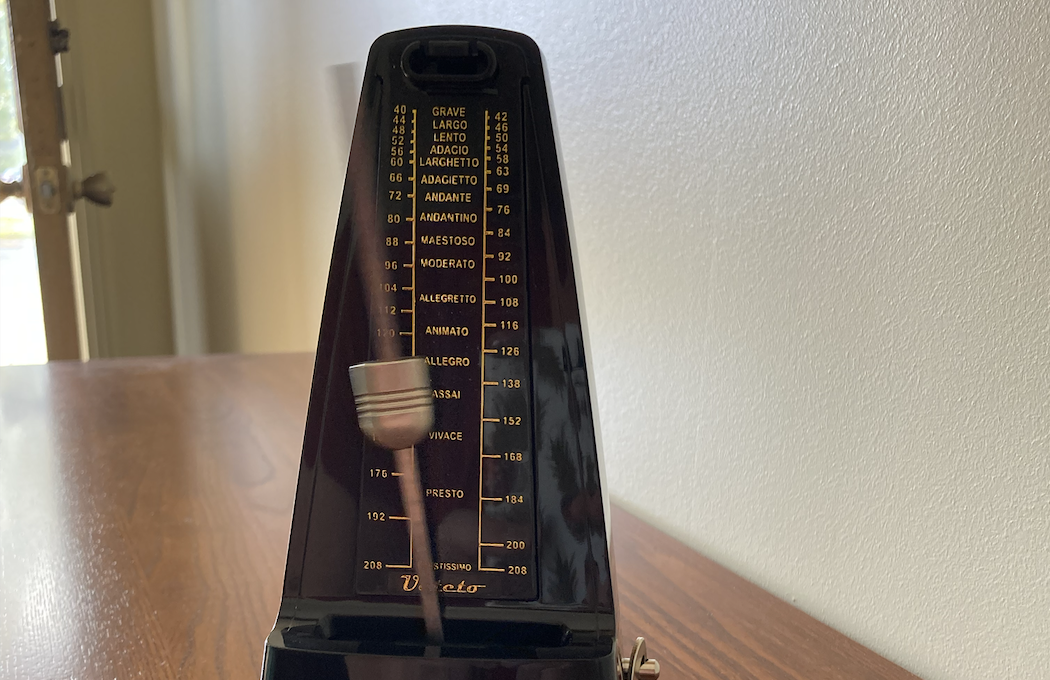I learned a valuable lesson at a vulnerable time, once. I was in graduate school, working on excerpts with my teacher and preparing for my second or third professional audition. We were studying the Mendelssohn Scherzo, that perennial first round staple that requires so much control and confidence, if you really want to pull it off. He had me slur through it at a slow speed, and I realized in that moment, to my total mortification, that I couldn’t play it perfectly when slow and slurred. Even though I’d been practicing that excerpt for about six years at that point, I did not actually know the melody!
Fast forward to now, so many years later, and I am busily preparing middle and high school students for their regional honor band auditions. The grade 11/12 technical excerpt this year is about eight lines of sixteenth notes with varied articulations at quarter equals 128. This has caused much wailing and gnashing of teeth, and I’d be lying if I didn’t admit that I will be very happy not to hear this one any more after Saturday’s auditions!
I think that my students’ preoccupation with meeting the tempo requirement is natural, and as we have moved through the final two weeks before the audition, some of them are sacrificing their phrasing, dynamics and the evenness of their technique in order to get all the way up to tempo. In lessons, we slow it down—way down—and doing so will frequently shine a spotlight on little moments of inconsistency, places where the student’s knowledge of the melody itself breaks down. I love teenagers, because they are dramatically horrified at my insistence that it’s not too late to go slow, but I’ll stand by that assertion. Even on Saturday morning, it’s not too late to go really slowly once or twice. Get your phrasing story straight, make sure you’re actually tonguing where you’re supposed to, really see the contour of the melody, the dynamics, the breath marks.
Give yourself a fighting chance to get it right!
As with most things, they eventually see it my way. Reducing the speed and increasing the level of attention to detail results in a better run when the piece is up to tempo, too, and this result is usually immediately apparent to the student. Here are a few pointers for cleaning up a technically difficult fast passage using this technique.
- Every phrase deserves direction. I find that really choosing direction within my phrasing makes difficult passages easier to play, and I set the guideposts for that phrasing when I’m working it out at a slow tempo. Notice the architecture of the piece and strive to make choices that bring out the unique beauty of what the composer has written. Are all the phrases the same length? If not, what’s the overall map like? Noticing these things makes it easier to be expressive.
- Articulation is there to help you. I find myself saying this nearly every day, at every level of teaching. The articulation, 98% of the time, will be helpful in terms of creating evenness and contour in the line. Literally tongue where it says—everywhere it says! At a slow speed, you can also work out finger/tongue coordination, which can be such a difficult thing to achieve and an easy thing to ignore when you’re playing something quickly.
- If you can’t do it slow, you can’t do it fast. I love it when a student says to me, “But I can play it right when I’m up to tempo!” It usually doesn’t take much time to convince them that that is not actually true—but when you’re up to tempo, you can’t hear what you’re doing with the precision required to actually play accurately and expressively. It feels right, but that doesn’t stand up to closer scrutiny. And there’s no feeling as good as the feeling you get when that technical passage clicks into place for real—when you’ve taken the time to really know it, really see it and really hear it, and it holds up at every speed.
- Breathing and rests have rhythm, too. Another thing I frequently notice is this: students see the eighth rest at the end of the bar, but they don’t account for it precisely—they take a quick breath and then actually come back in too soon, before the downbeat of the next measure has actually happened. Breathing shallowly also means that they wind up without enough air to execute the next phrase, which means taking more breaths, which means getting a bit behind that pesky metronome, which leads to the belief that they simply can’t actually play the thing at tempo…when what they truly need is simply to breathe and to give the rest its allocated time. Again, at that crazy fast speed, it’s natural for our breathing to become shallower and shallower. Practicing the choreography of it all at a slower pace allows us to really feel and experience and know everything that is actually there. And then, when it’s all put together and we’ve got our story straight, we’ll crank that tempo and go!


Wow… my teacher reminded me the other day that I should play studies slowly all the way through. Don’t worry about pace., even if I can’t play it at the marked tempo after a week. Your article explains why! Than you!
Thank you for your wonderful comment, Peter! And don’t worry–we all fight this battle in our own practice. I write to remind myself as well as my students!
Wonderful article, Jessica! Keep preaching these eternal truths.
Thank you, Carol!
[…] The Flute Examiner (Jessica Dunnavant): Watch Your Speed! […]